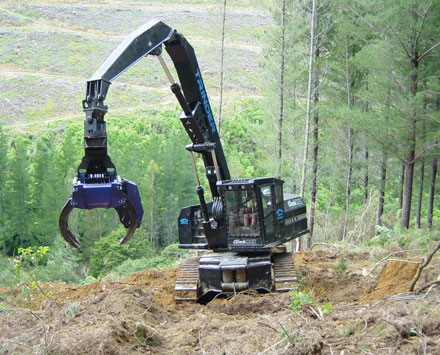Nigel Kelly, of Kelly Logging, said the ClimbMAX winch-assisted harvester had been working in Marlborough and Nelson forests in New Zealand since being developed in 2005 to increase production and reduce accidents. Source: Stuff co nz
The seven-month manufacturing turnaround for each machine is steadily grabbing the attention of more offshore buyers.
Marketed by ClimbMAX International, five machines have been sold to Canada but more inquiries were coming from the US with contracts already signed to supply three machines, he said.
“The machine is revolutionising the way harvesting is viewed globally, and this is been shown by increasing interest from the more traditional logging sectors in the Pacific North West,” Mr Kelly said.
He said sales inquiries were being fielded from North America on a weekly basis since the first machine was sold in 2008.
The company has sold 13 machines in New Zealand and overseas.
While there were other harvesters developed for steep slopes, none had been designed to do the work the ClimbMAX did, he said.
Mr Kelly, a fifth generation Nelson logging contractor, developed the machine with a group of Nelson-based engineering and electrical firms to harvest radiata trees on steep slopes up to 45 degrees gradient.
The harvester eliminated the need for loggers to work around cable haulers, felling trees by hand on the ground, and breaking out.
Those roles are among the most dangerous in the logging industry, which has developed safer work techniques to cut accident rates.
The machine also took away the need to build forestry roads to truck the logs out, meaning less costs from earthworks.
The harvester can ‘shovel’ fallen trees into bunches to be hauled to the skid site at the bottom of the hill.
Production had increased between 20% and 40% and on a private forest site near Blenheim the machine was topping production to about 300 tonnes a day.
“It has changed the logging business almost overnight for us,” Mr Kelly said. “Traditionally the industry has been one dimensional.
“With a machine like this, we now have a whole tool box of different opportunities to plan how we harvest.”
Basically the harvester is a rebuilt excavator, with every component except the radiator totally remodified from the ground up, and eight tonnes of weight removed to lower the centre of gravity at the base.
Among the modifications is a high tensile steel boom with a longer 10 metre reach attached to the grapple.
With a 42 tonne gross weight, including a 2.3 tonne head unit, and 190kW power output, the ClimbMAX made easy work of harvesting steep slopes. But the main difference from other excavator harvesters is its fully integrated computer driven winch system working in tandem with the base machine operation.
The winch, including a 380m cable with a 15 tonne line pull, helped stabilise the machine on steep slopes, and increase traction for the base machine to climb back up the slope.
“The difference is that the computer system, not the operator, is working the winch,” he said.
“If the winch rope failed the machine would still have traction.”
Each machine sold for about $1.2 million but total development costs are far greater. Kelly said many would argue whether it was worth spending the money.
“It’s not a widely used system but it is a long term project and will become more common practice for groundbased harvesting in the future.
“At the end of the day if I can’t stop injuries on the job, I don’t really have a future in the industry.”
Kelly Logging operator Paul Gardiner said the harvester’s attraction was it ability to work on slopes other machines were unable to access.
“It’s a challenging job but I feel a lot safer in this than other machines,” Mr Gardiner said.








